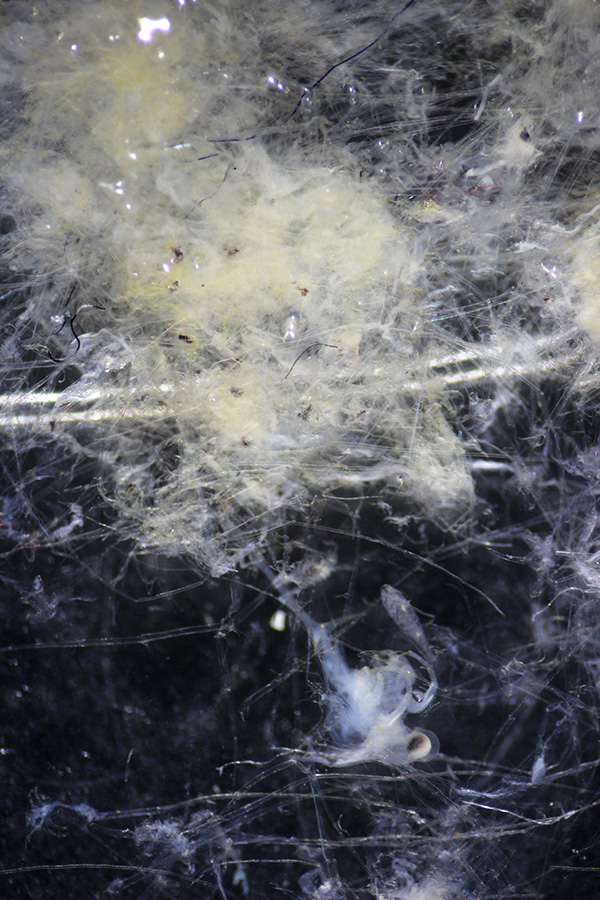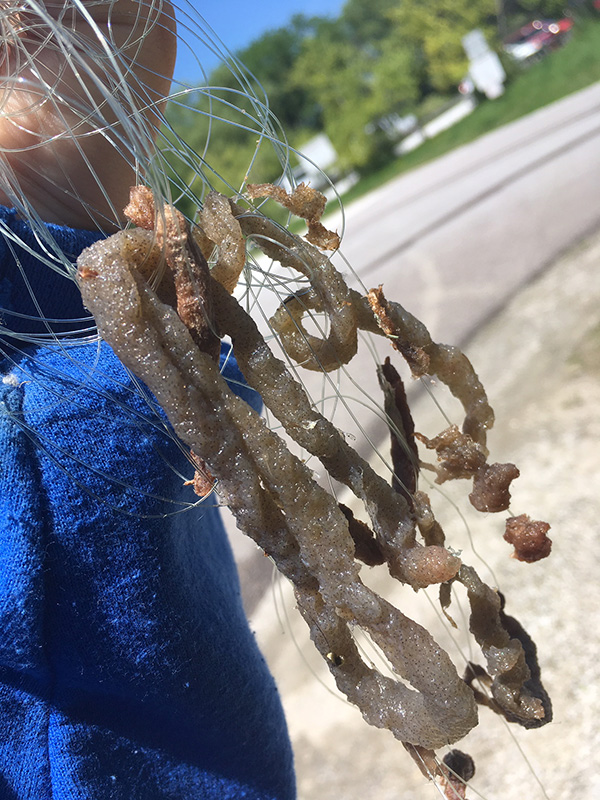News Release: Fishhook waterflea infests Lake Champlain
Grand Isle, VT – Anglers returning from the waters of Lake Champlain at Shelburne Bay have reported large quantities of invasive fishhook waterflea fouling their gear. Boat launch stewards with the Lake Champlain Basin Program (LCBP) noted this week that nearly all fishing boats returning to the Shelburne Bay and Converse Bay launches had downriggers infested with the tiny organisms. LCBP stewards removed, treated, and disposed of the fishhook waterfleas. The alarming news for anglers and lake ecology comes during the busy holiday period of Canada Day on July 1 and the July 4th holiday in the U.S.
Like the spiny waterflea, which was confirmed in Lake Champlain in 2014, the fishhook waterflea is an aggressive predator of plankton that are food for native species in the lake. There are no known risks to human health from the fishhook waterflea, but they are known for fouling fishing gear.
Scientists first noted fishhook waterflea (Cercopagis pengoi)in Lake Champlain in summer 2018. The species is the 51st known aquatic nonnative and invasive species in Lake Champlain. While more than 100 individual waterfleas were present in samples collected in 2018, the number of individuals found on fishing equipment in Shelburne Bay this week numbered in the thousands. The Lake Champlain Research Institute confirmed that organisms collected off of fishing lines of boats exiting the lake this week were fishhook waterfleas and a small number of spiny waterfleas.
The fishhook waterflea is a native of Eurasia. It arrived in the Great Lakes in ballast water in the 1980s and spread to other water bodies. It likely arrived in Lake Champlain by hitchhiking overland on recreational boats, trailers, fishing lines, and other equipment. The Finger Lakes in New York and Lake Ontario are the closest lakes known to host the species.
While the impact from this species to the Lake’s food web is unknown, researchers have observed shifts in the zooplankton community after the detection of spiny waterflea in Lake Champlain and other lakes where the species has become established. The waterflea eggs are resistant to drying, which limits the types of management actions that will prevent the spread of this species.
Because fishhook waterflea has life stages that are invisible to the naked eye, they are often difficult to detect. Lake users are asked to take measures to help prevent the spread of fishhook waterflea to other inland water bodies. Boaters are encouraged to clean, drain and dry their boats, trailers, and equipment. They should drain bilge water and check anchor lines. Anglers should change fishing lines and tackle when moving between water bodies.
“These invasive waterfleas pose a risk not only to the ecology of our lakes and ponds, but also to anglers’ enjoyment of fishing,” said Louis Porter, commissioner of the Vermont Fish and Wildlife Department. “We count on anglers and boaters both to clean, drain and dry their boats and equipment to prevent the spread of invasives. Species like the fishhook water flea are easily overlooked so closer inspection may be necessary. Boaters and anglers are also often the first to notice when new invasives reach Vermont – thanks for taking the time to prevent the movement of invasive species around Vermont.”
Hot water, high pressure decontamination of boats and equipment that are in contact with water bodies known to contain fishhook waterflea is recommended. The LCBP operates decontamination stations at the John Guillmette launch in South Hero, Shelburne Bay, and Colchester VTFWD fishing access launch. Decontamination stations are available at the South Bay, Ticonderoga, Port Henry, Willsboro, Port Douglas, Peru, and Plattsburgh NYSDEC launches operated by the Adirondack Watershed Institute.
No known control methods exist to eliminate fishhook waterflea once established in a water body. Efforts will focus on preventing the spread of this species to other water bodies in the region.
Additional Contacts:
Dave Winchell, New York State Department of Environmental Conservation Region 5 (518) 897-1241
Vermont Department of Fish & Wildlife (802) 828-1000 fwinformation@vermont.gov
Additional Information:
USGS Fishhook Waterflea Fact Sheet: https://nas.er.usgs.gov/queries/factsheet.aspx?SpeciesID=163
-end-
The Lake Champlain Basin Program coordinates and funds efforts that benefit the Lake Champlain Basin’s water quality, fisheries, wetlands, wildlife, recreation, and cultural resources. The program works in partnership with federal agencies, state and provincial agencies from New York, Vermont, and Québec, local communities, businesses, and citizen groups. For further information about the program, contact the Lake Champlain Basin Program, 54 West Shore Road, Grand Isle, VT at (802) 372-3213 / (800) 468-5227 or visit www.lcbp.org.

